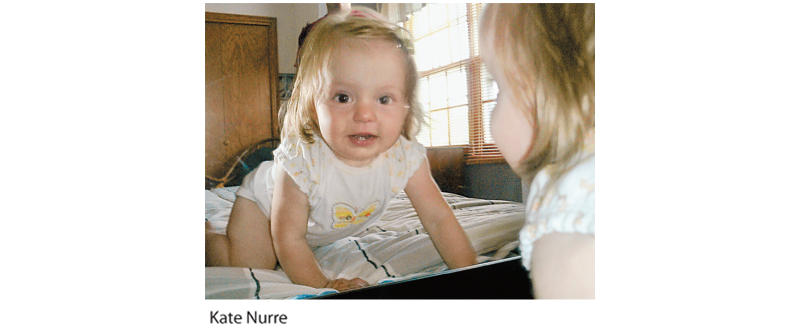Developing a Self-Concept
Infancy’s major social achievement is attachment. Childhood’s major social achievement is a positive sense of self. By the end of childhood, at about age 12, most children have developed a self-concept—an understanding and assessment of who they are. (Their self-esteem is how they feel about who they are.) Parents often wonder when and how this sense of self develops. “Is my baby girl aware of herself—does she know she is a person distinct from everyone else?”
Of course we cannot ask the baby directly, but we can again capitalize on what she can do—letting her behavior provide clues to the beginnings of her self-awareness. In 1877, biologist Charles Darwin offered one idea: Self-awareness begins when we recognize ourselves in a mirror. To see whether a child recognizes that the girl in the mirror is indeed herself, researchers sneakily dabbed color on her nose. At about 6 months, children reach out to touch their mirror image as if it were another child (Courage & Howe, 2002; Damon & Hart, 1982, 1988, 1992). By 15 to 18 months, they begin to touch their own noses when they see the colored spot in the mirror (Butterworth, 1992; Gallup & Suarez, 1986). Apparently, 18-month-olds have a schema of how their face should look, and they wonder, “What is that spot doing on my face?”

Self-awareness Mirror images fascinate infants from the age of about 6 months. Only at about 18 months, however, does the child recognize that the image in the mirror is “me.”
By school age, children’s self-concept has blossomed into more detailed descriptions that include their gender, group memberships, psychological traits, and similarities and differences compared with other children (Newman & Ruble, 1988; Stipek, 1992). They come to see themselves as good and skillful in some ways but not others. They form a concept of which traits, ideally, they would like to have. By age 8 or 10, their self-image is quite stable.
Children’s views of themselves affect their actions. Children who form a positive self-concept are more confident, independent, optimistic, assertive, and sociable (Maccoby, 1980). So how can parents encourage a positive yet realistic self-concept?